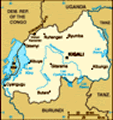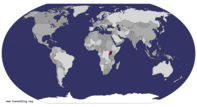Advertisement
Published: June 13th 2007
I have to admit that for a very long time I thought of Rwanda solely in terms of the genocide of 1994. I have read several books about it, including Shake Hand With The Devil by Lt. Gen. (Ret.) Romeo Dallaire, whom I had the chance to meet and talk with in January 2006, so I thought that I knew what Rwanda was about. I thought I knew what I was getting into when I flew here in April, though I knew that it wouldn't be as bad as it is described in Skake Hands, since it has been 13 years since the world watched in horror for three months while the genocide unfolded. I quickly discovered that I did not know anything about what Rwanda is like, and that the people here have a marvelous ability to rebuild and move on.
The rebuilding of Rwanda, while mostly carried on the shoulders of the Rwandan people, has been significantly aided by many foreign governments, Non-Governmental Organizations (NGOs) and generous philanthropic individuals. One such NGO, with whom I am volunteering, is the Anderson Association, created in November 2004 by Chris and Safieh Anderson, two of the above mentioned philanthropic individuals. The

 The Clinic Interior
The Clinic Interior
(Front, not visible) Main Entrance
(L-R, F-B) Birthing Room, Consultation Room/Office, Bedroom 1, Observation Room, Bathroom, Laboratory, Bedroom 2, Secondary Entrance
(Back) Meeting HallAndersons moved to Rwanda in late 1994 with their three children to work within and help rebuild the Rwandan community. The first project undertaken by the Anderson Association is the Joan Anderson Memorial Dispensary. The dispensary is a project “inspired by the life of Joan Anderson”, Chris’ mother, a Canadian nurse “dedicated to the advancement of native peoples...and who loved Africa very much” , who passed away in 2000.
The dispensary is situated on Mt. Rebero in the district of Gatenga, which overlooks the Rwandan capital city, Kigali. Easily accessible by any land-based form of transportation, the property on which the clinic was built is open 24 hours a day, 7 days a week to the public, and the clinic is staffed around the clock. The property also includes housing for grounds staff, the Anderson’s house and several ongoing projects including a training centre and community library.
The clinic is currently staffed by three nurses: Marguerite Ntaurigomura, a native Rwandan who has worked at the clinic since it began operation; Cock Zabika, who began work at the clinic in mid-May 2007; and Jacintha Gabriel, a Canadian volunteer who arrived in Rwanda on the 8th of June, 2007.
Construction on the

 Birthing Room
Birthing Room
Door is out of the picture to the left.clinic began several years before the creation of the Anderson Association, when the foundations were laid. Construction of the actual building began in early 2005 and proceeded sporadically, heavily dependent on donations from Canadian and American fundraising efforts as well as fluctuations in the cost of materials. The clinic is a 12x22 meter building with concrete block walls, concrete floors, a corrugated sheet metal roof and stained particle-board ceilings. It has a patient consultation room/nurse’s office, an observation room with two beds for overnight patients, a primitive laboratory/surgery for running tests and tending patients, a birthing room, a meeting hall and two rooms and a bathroom to house clinic staff. By September 2005 over $80,000 CND had been invested in developing the clinic site, worker housing, small meeting huts and preparations for future projects.
The main construction and furnishing was completed by early 2006 and the clinic began operation on the 8th day of April, providing basic health care needs to approximately 30,000 inhabitants of Gatenga and Butamwa, as well as people from several other surrounding areas.
On the first day of operation the clinic treated two people. In the first month there were 61 patients, and by the end

 Consultation Room/Office
Consultation Room/Office
With Papa Jean (standing) and Zabika Cock (seated).of 2006 the clinic had treated 1024 people. The clinic now treats up to 20 people per day, over 200 persons a month, and nearly reached the total from 2006 by the end of June 2007. The clinic was designed to treat up to 100 people per day when fully operational, with all the necessary materials, equipment, medicines, staff and a well-established reputation.
The Joan Anderson Memorial Dispensary, however, is not the only clinic in the area. While talking with patients and the staff at the clinic I learned that there are several other clinics in and around Kigali, as well as government hospitals in the city. These other clinics are not as popular as the Anderson clinic however. “They are not nice,” says one patient. “If you don’t have any money they throw you out. They don’t care as much about that .” Another patient concurs, adding that the medical service at the Anderson clinic is better than elsewhere.
One young mother, staying overnight at the clinic with her 3 week old daughter with malaria, says that to her, the clinic represents security. “Before, when someone got sick in my village, they would die, and have

 Observation Room
Observation Room
Sorry, small room, impossible to find an angle that sees the whole room.to be buried near the road. We have no money to pay for the clinics in Kigali. Now we have somewhere where we can go.” Her baby was delivered without complications at the clinic at about midnight on May 12 by Zabika, the nineteenth birth at the clinic, the first since my arrival.
“ pays small and lonely homage to the World Health Organization’s goal of health care for all by the year 2000”, says Jacintha Gabriel. It is the only clinic in or around Kigali, very likely in all of Rwanda, where people can go and receive health care, whether or not they can pay. If the nurses find that they are unable to treat a particular ailment, the patient is directed to a hospital in Kigali and given an official medical record of the nurses’ assessment to increase the likelihood of the patient receiving treatment at the hospital although once again this is dependent on payment.
Though the clinic is fully functional and provides health care superior to that of other clinics in the area, it is still “a far cry from the standards of North American clinics and hospitals”, says Gabriel. She adds that “stepping into

 Laboratory
Laboratory
There is also a microscope. The centrifuge attached to the far end of the table is powered by hand crack. the clinic is like stepping into the 1950’s in Canada.” The clinic has a very limited supply of anesthetics which are used solely for suturing, even though one of the most common ailments is small children with severe burns which require debriding, in which the charred skin is scraped off. They lack many other basic materials such as non-stick gauze for burns, a sterile surgery field, emergency respiratory medications for trauma patients (who account for a significant portion of people treated at the clinic) and sterile, sharp suture needles and surgical scissors. The laboratory has only a basic microscope, the type used by grade school students to look at hairs and leaves, and the centrifuge used for tests is hand-cranked, making it nearly impossible for it to go fast enough to properly separate materials within test samples of blood and urine. This means that the clinic is very restricted in what it can treat, and most procedures - including births, suturing of large wounds and removal of objects from eyes and ears - are done with little to no anesthetic and in non-sterile environments.
The clinic manages to treat patients for a wide variety of ailments, though, from pains to

 Bedroom 2
Bedroom 2
Bedroom 1 is identical.broken limbs, birth control to pregnancy tests to delivery, rotten teeth to collapsed lungs. The most common procedure done at the clinic is testing for malaria, one of the leading killers in sub-Saharan Africa. In 2006 over half of all patients were tested for malaria, most tests being positive, resulting in over five hundred prescriptions of Quinine and other anti-malarial drugs. Other common tests done in the laboratory include fertility and HIV tests, with mostly positive and negative results, respectively. Out of 93 HIV tests done by the end of March 2007, only one was recorded as positive. Several others had no recorded result, but as no drugs or other treatments were prescribed, it can be assumed that they were negative.
Tests and medications are expensive, though, and the monetary situation is less than rosy. Clinic fees - for consultation, medicine and lab tests - are supposed to cover the basic maintenance and operation costs, as well as some or all of the nurses’ wages. Many patients, unfortunately, do not have enough or even any money to pay for the services of the clinic, and are treated pro-bono. The current system in the clinic is that the patients are treated

 Meeting Hall
Meeting Hall
Ceiling under construction.and the tests are done, and then they are asked to pay for the consultation and whatever medicine or lab tests they received. At most other clinics they request money before tests are done or medication is prescribed. This raises the question; is it better to ensure payment, thereby allowing the clinic to attract workers and buy all the materials and medicine they want, or to serve all and sundry, regardless of receiving payment, and subsist on charity and donations of materials?
The management and staff of the clinic have chosen to take the “all and sundry” approach, and appear to making a success out of it. The clinic has become very popular, with patient loads on the rise, a slowly accumulating resource of materials and plans to further upgrade in the future, including the addition of a computer and eventually an internet connection. The final stage of construction - the interior - is almost complete, with the last of the ceiling panels going up and nearly all the lights and wall-plugs installed and running, although they still lack running water.
Having provided fast, efficient and cheap - in many cases, free - medical service to over 2000 people since

 Main Hall
Main Hall
With ceiling under construction.beginning operation just over one year ago, the Joan Anderson Memorial Dispensary has indisputably made a difference in local community, and will undoubtedly continue to do so for many years to come.
For more information on or to donate to the Anderson Association and the dispensary, visit www.andersonassociation.com
Advertisement
Tot: 0.086s; Tpl: 0.014s; cc: 10; qc: 55; dbt: 0.0395s; 1; m:domysql w:travelblog (10.17.0.13); sld: 1;
; mem: 1.2mb














Keep Smiling
Mike Fossey
Chirurgie
Petite Chirurgie translates as small surgery. Hope that helps. Best wishes for the clinic's continued success - and Keep Smiling!